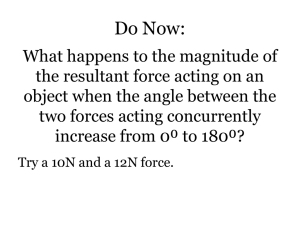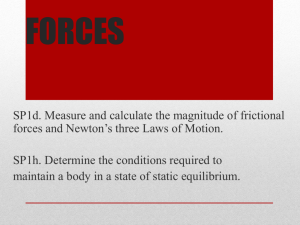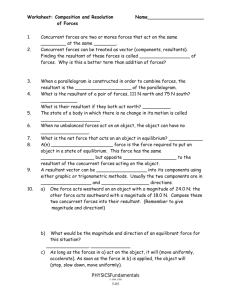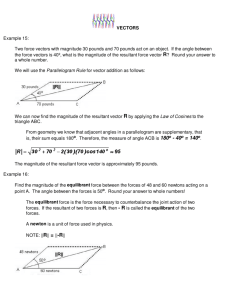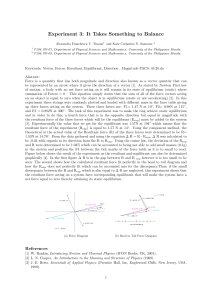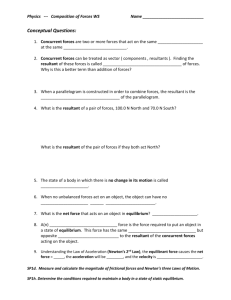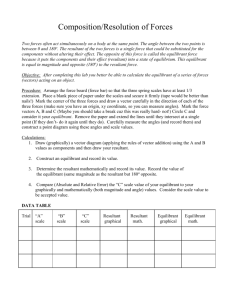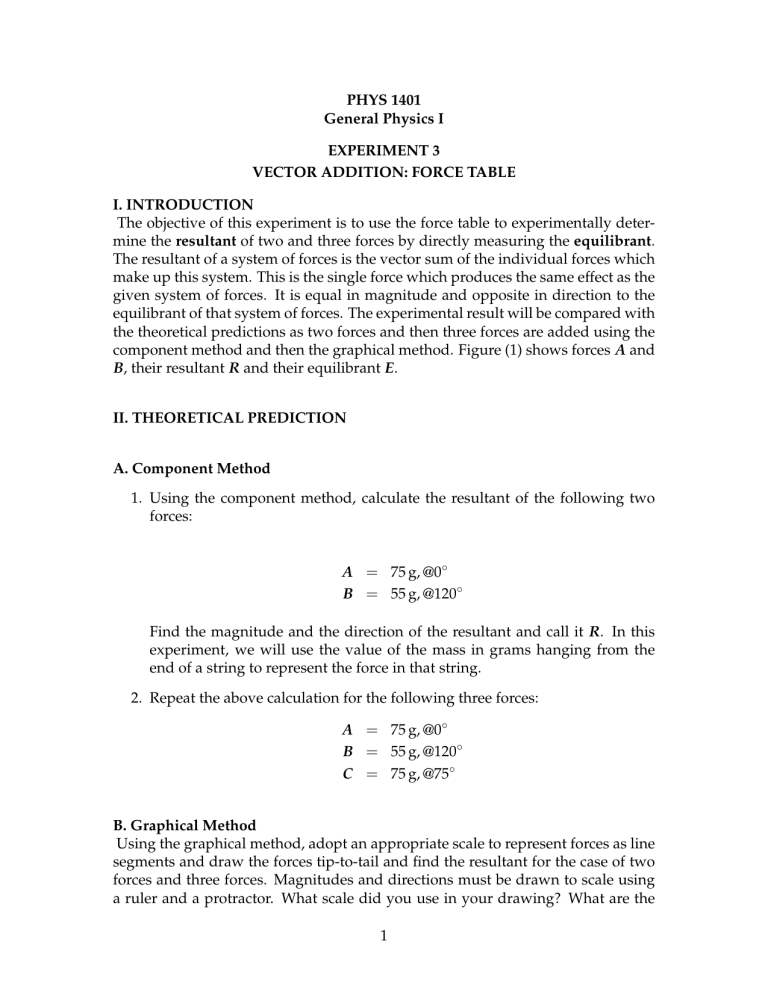
PHYS 1401 General Physics I EXPERIMENT 3 VECTOR ADDITION: FORCE TABLE I. INTRODUCTION The objective of this experiment is to use the force table to experimentally determine the resultant of two and three forces by directly measuring the equilibrant. The resultant of a system of forces is the vector sum of the individual forces which make up this system. This is the single force which produces the same effect as the given system of forces. It is equal in magnitude and opposite in direction to the equilibrant of that system of forces. The experimental result will be compared with the theoretical predictions as two forces and then three forces are added using the component method and then the graphical method. Figure (1) shows forces A and B, their resultant R and their equilibrant E. II. THEORETICAL PREDICTION A. Component Method 1. Using the component method, calculate the resultant of the following two forces: A = 75 g, @0◦ B = 55 g, @120◦ Find the magnitude and the direction of the resultant and call it R. In this experiment, we will use the value of the mass in grams hanging from the end of a string to represent the force in that string. 2. Repeat the above calculation for the following three forces: A = 75 g, @0◦ B = 55 g, @120◦ C = 75 g, @75◦ B. Graphical Method Using the graphical method, adopt an appropriate scale to represent forces as line segments and draw the forces tip-to-tail and find the resultant for the case of two forces and three forces. Magnitudes and directions must be drawn to scale using a ruler and a protractor. What scale did you use in your drawing? What are the 1 magnitude and the direction of the resultant found from this method for the twoforce case and the three-force case? III. APPARATUS ME-9447 Force Table, pulleys, pulley clamps, mass hangers, mass set, strings. IV. EXPERIMENTAL PROCEDURE: 1. Set up the force table and use the bubble to make sure it is horizontal. 2. Hang a mass of 70 g from one of the strings and align it at angle zero. The mass of the hanger is 5 g. This gives a total hanging mass of 75 g. 3. Hang a mass of 50 g from another string and align it at angle 120◦ . 4. Adjust the pulleys downward until the strings are close to the surface of the force table but not touching it. 5. Measure the equilibrant: by trial and error, find the angle for the third pulley and the mass which must be suspended from it that will balance the other two forces. The forces are balanced when the knot is centered over the hole in the middle of the center post. The anchor string should be slack. 6. Pull the center knot slightly to one side and let it go. The knot should return to the center. This indicates that the center knot is in equilibrium. When you are satisfied this is the case, record the magnitude and the direction of the equilibrant in the data table.This is the force exerted by the third string. 7. The measured resultant of the two forces is equal in magnitude and opposite in direction to the measured equilibrant. 8. In your data, record the magnitude and the direction of the resultant force. 9. Repeat the experimental procedure for the three froces A, B and C and record the magnitude and direction of the measured equilibrant and resultant. V. ANALYSIS: 1. For each case, calculate the percent difference between the calculated resultant and the measured resultant % difference = Rth − Rexp × 100. Rth + Rexp 2 2. Write a conclusion summarizing your results. Comment on the success of this experiment. Is your result in agreement with the law of vector addition? Explain any percent differences which are larger than 5%. What do you think are the two most important sources of error? 2 Results of the Component Method Magnitude of Direction of Resultant Resultant Two Forces Three Forces Results of the Graphical Method Magnitude of Direction of Resultant Resultant Two Forces Three Forces Experiment (3) Data Table Magnitude of Direction of Magnitude of Direction of Equilibrant Equilibrant Resultant Resultant (Measured) (Measured) (Measured) (Measured) Two Forces Three Forces 3
